Thera Wall Paintings Copies P. Nomikos Museum
The life-sized three-dimensional wall-paintings reproduced and exhibited here were sponsored by the "Thera Foundation, Petros M. Nomikos", and produced in France by Transfer Relief SA, using the Kodak Pathé process. Other similar Kodak Pathé commissions have been funded by the Getty Museum of California and the French government for the Egyptian tomb of Sennefer and the Lascaux Caves, respectively.
The manufacturing of these images involved a long, complex, and laborious process which necessitated the transfer of photographic emulsions onto a synthetic substrate that exactly replicates that of the original wall-painting plaster. This substrate was generated from a stereo-photogram of the original wall-painting in much that same way satellite imagery is used to render computerized topography in 3D.
Following the completion of the substrate, the photographic emulsion was then bonded to create the wall-paintings presented in the museum and shown in this album. Each image in the museum is rendered in a 1/1 scale, and has been stereo photographed using 20x25 cm. negatives so as to reduce peripheral image distortion and provide the very highest resolution. The results are exceptionally realistic and accurate, and this exhibition in Fira remains the only place where one can view, enjoy and study all of the wall-paintings of Thera.
For more detailed information about the technical and artistic aspects of the wall-paintings restoration please consult The Petros Nomikos Museum of Wall-Paintings of Akrotiri : A detailed reference for the inquisitive traveller.
Photos: Michael Tziotis
Select Page of the Album:
Click on any of the pictures to enlarge.
“The House of the Ladies”The House of the Ladies is located in the northwestern section of the excavation. It is a three storey edifice of ten rooms on each floor. Its entrance is located at the southwestern section of the building.
A light-well was found in the center of the structure and is the only example found to date in Akrotiri. The light-well is a structural feature typical of the Cretan Palatial architecture. The light-well and the fine items found in the rooms lead us to believe that the House was a rich private residence.
Room 1, divided in two sections (eastern and western) has yielded a wealth of wall-paintings. The image of the “Female Figure” and the “Bare-Breasted Woman” were painted on the walls of the eastern section. Sadly, destruction of the eastern wall led to an incomplete scene. Images of “Sea Daffodils” were painted on the three walls of the western section.
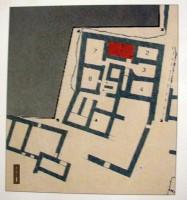
“The House of the Ladies”: Plan of the building |
|
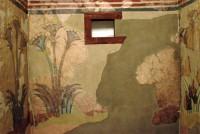
“Sea Daffodils” in Room 1
House of the Ladies, Room 1, West section, South wall, H. 2.70m W. 1.75 m, West wall, H. 2.70m, W. 2.10m. North wall H. 2.70 m, W 1.73
Three stemmed blossoming plants are drawn in the middle zone of the walls. The lower zone is painted in a reddish-yellow color. The upper zone is rendered with nine narrow bands of three alternating colors.
The identification of these plants has caused much academic debate. Since the late 1960s, they have been recorded as sea-lilies. Sea-lilies (Pancratium Maritimum Ι.) still grow on the beach and seaside of Santorini, blooming in late summer.
More recent studies have concluded that these flowers are more likely to be papyrus (Cyperus Papyrus). Not only do the Theran stylistic renditions of these flowers have parallels in Egyptian papyrus imagery, but also evidence at the Archaeological Museum at Chania. Crete, suggests the existence of papyrus in Crete during the Bronze Age.
Furthermore, the height of the flowers, as depicted in the wall-paintings, indicate a scale better suited to a papyrus than to a sea-lily. The sea-lily grows to a maximum height of only 30-40 cm., while the papyrus grows to up to 3 m. and displays a symmetry equivalent to the flowers in this wall-painting. |
|
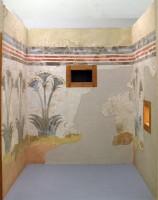
“Sea Daffodils” in Room 1
Another photo of the room reproduction, this one at the Archaeological Museum in Thera. |
|

“Sea Daffodils”
The flowers depicted in the left wall shown in the previous photos |
|
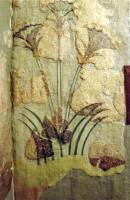
“Sea Daffodils”
The flowers depicted in the right wall shown in the previous photos |
|
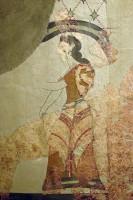
“Female figure”, House of the Ladies, Room 1. East section. South wall. H. 2.20 / W. 2.05 m
This is part of the complex “Female figure” and “Female figure with naked breast”, House of the Ladies, Room 1. East section. South wall. H. 2.20 / W. 2.05 m. Room 1. East section. North wall. H. 2.25 / W. 1.19 m.
In the eastern section of Room 1, two female figures are engaged in an unknown activity, and a third figure is present; however, only a small portion of the figure's skirt and forearm remain. This wall-painting is in poor condition and once extended along the northern and southern walls, possibly also covering the eastern wall.
Both the women depicted (the second one shown in the following two photos) have long black hair and a characteristic red streak on their cheeks. This figure on the south wall is wearing a short-sleeved bodice and a skirt; her left arm is raised in front of her. The figure on the north wall, shown next, is bending down, with her left arm outstretched, exposing her breast.
Few wall-painting fragments were found on the eastern wall. The surviving image depicts part of a skirt and forearm, providing evidence of a third figure, possibly seated.
The most popular interpretation of this wall-painting suggests a religious significance. The third/missing woman may have been a “priestess” towards whom the other two women are moving. An alternative interpretation is that this wall-painting celebrates an important event in the life of the third, missing figure. |
|
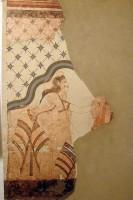
“Female figure with naked breast”, House of the Ladies, Room 1. East section. North wall. H. 2.25 / W. 1.19 m
This is also part of the “Female figure” and “Female figure with naked breast” complex, House of the Ladies, Room 1. East section. South wall. H. 2.20 / W. 2.05 m. Room 1. East section. North wall. H. 2.25 / W. 1.19 m.
In the eastern section of Room 1, two female figures are engaged in an unknown activity, and a third figure is present; however, only a small portion of the figure\'s skirt and forearm remain. This wall-painting is in poor condition and once extended along the northern and southern walls, possibly also covering the eastern wall.
Both the women depicted have long black hair and a characteristic red streak on their cheeks. This figure on the north wall is bending down, with her left arm outstretched, exposing her breast. |
|
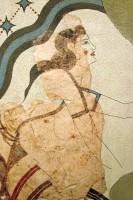
“Female figure with naked breast” (Detail) |
|
Select Page of the Album:
|
|



